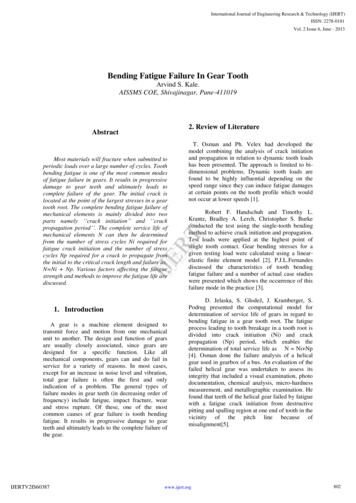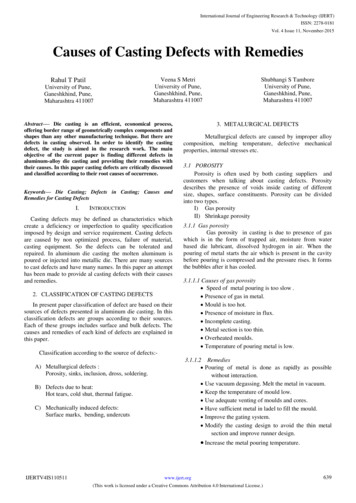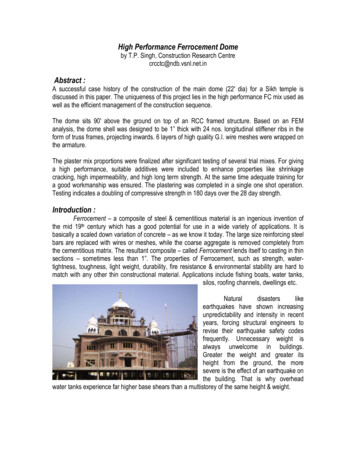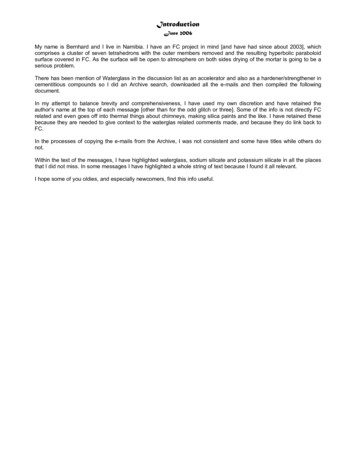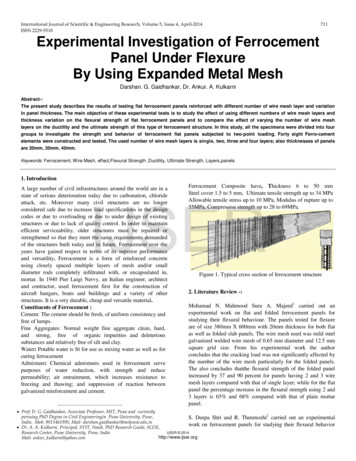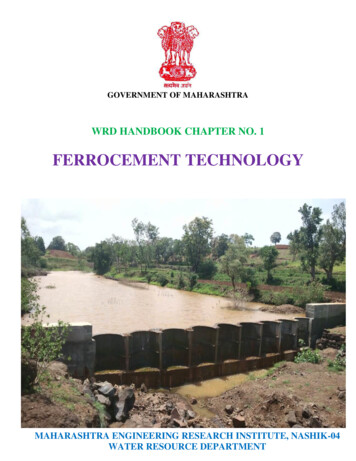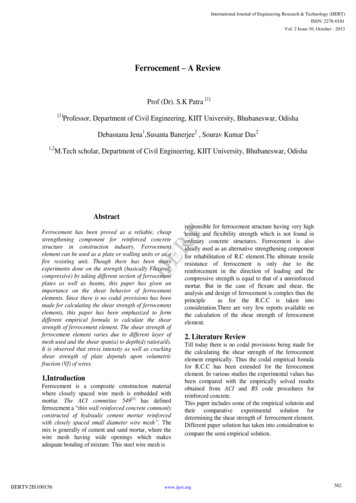
Transcription
International Journal of Engineering Research & Technology (IJERT)ISSN: 2278-0181Vol. 2 Issue 10, October - 2013Ferrocement – A ReviewProf (Dr). S.K Patra [1][1]Professor, Department of Civil Engineering, KIIT University, Bhubaneswar, OdishaDebasnana Jena1,Susanta Banerjee2 , Sourav Kumar Das21,2M.Tech scholar, Department of Civil Engineering, KIIT University, Bhubaneswar, OdishaAbstractresponsible for ferrocement structure having very hightensile and flexibility strength which is not found inordinary concrete structures. Ferrocement is alsoideally used as an alternative strengthening componentfor rehabilitation of R.C element.The ultimate tensileresistance of ferrocement is only due to thereinforcement in the direction of loading and thecompressive strength is equal to that of a unreinforcedmortar. But in the case of flexure and shear, theanalysis and design of ferrocement is complex thus theprincipleas for the R.C.C is taken intoconsideration.There are very few reports available onthe calculation of the shear strength of ferrocementelement.IJERTFerrocement has been proved as a reliable, cheapstrengthening component for reinforced concretestructure in construction industry. Ferrocementelement can be used as a plate or walling units or as afire resisting unit. Though there has been manyexperiments done on the strength (basically Flexural,compressive) by taking different section of ferrocementplates as well as beams, this paper has given animportance on the shear behavior of ferrocementelements. Since there is no codal provisions has beenmade for calculating the shear strength of ferrocementelements, this paper has been emphasized to formdifferent empirical formula to calculate the shearstrength of ferrocement element. The shear strength offerrocement element varies due to different layer ofmesh used and the shear span(a) to depth(d) ratio(a/d).It is observed that stress intensity as well as crackingshear strength of plate depends upon volumetricfraction (Vf) of wires.1.IntroductionFerrocement is a composite construction materialwhere closely spaced wire mesh is embedded withmortar. The ACI committee 549[1] has definedferrocement a “thin wall reinforced concrete commonlyconstructed of hydraulic cement mortar reinforcedwith closely spaced small diameter wire mesh”. Themix is generally of cement and sand mortar, where thewire mesh having wide openings which makesadequate bonding of mixture. This steel wire mesh isIJERTV2IS1001562. Literature ReviewTill today there is no codal provisions being made forthe calculating the shear strength of the ferrocementelement empirically. Thus the codal empirical fomulafor R.C.C has been extended for the ferrocementelement. In various studies the experimental values hasbeen compared with the empirically solved resultsobtained from ACI and BS code procedures forreinforced concrete.This paper includes some of the empirical solutoin andtheir comparative experimental solution fordetermining the shear strength of ferrocement element.Different paper solution has taken into consideration tocompare the semi empirical solution.www.ijert.org562
International Journal of Engineering Research & Technology (IJERT)ISSN: 2278-0181Vol. 2 Issue 10, October - 20133. Factors Affecting Shear Strength OfFerrocement ElementFrom the different experimental studies on ferrocementit has been found that the strength of ferrocementelement in shear affects due to the shear span (a) todepth (d) ratio (a/d) and volumatric fraction (Vf) ofmesh reinforcement.PaNow the cracking shear strength of the can becalculated analytically [3]. The following equation hasbeen derived to predict the shear capacity offerrocement plate.PaCracking shear strength (𝜗𝑐𝑟):-d𝜗𝑐𝑟 (0.27 𝑉𝑓0.65) (Fcu (d/a))0.65Where,𝑉𝑓 volume fraction of mesh depending upon size ofopeningfcu Mortar compressive strengtha shear spand Overall depth of plate.wire meshsupportWhere N No. of mesh layer, 𝜋 3.14,𝑑𝑤 Diameter of wire meshDl distance center to center between longitudinalwiresDt distance center to center between transverse wiresh thickness of ferrocement platesupport4.2. Method 2-EmpiricalCalculating The ShearFerrocement elements[6]formula ForCapacity OfIJERTFig 1:- Set up that showing the factors affecting strength offerrocement element4. Different proposed Empirical Solutionfor calculating the shear capacity OfFerrocement element4.1. Method 1 - Calculation of cracking shearstrength of ferrocement plates [2]According to the reference no.2 the increase in thevolume fraction (Vf) of the wire mesh layersubsequently increase in the shear carrying capacity ofthe ferrocement plate. It is observed that stressintensity as well as cracking shear strength of platesdepends upon volume fraction[2]. The experiment hasbeen carried out by taking a section of [490 230 20mm] and the test result is being verified by using theFEM (Ansys) [4].From the above experiment it has been found thatHexagonal mesh improves the shear capacity than thatof Diamond and Square mesh because higher straightlength[5]. From these results it has been found thatstrength depends upon volume fraction(Vf). Thevolumetric function all type of mesh can be calculatedby using formula.For square mesh:V𝑓 IJERTV2IS100156(N / 4) (Пdw2/h)[(1/Dl) (1/Dt)]In this section[6] a rectangular section of size[600 150 25 mm] has been tested experimentally andthe value is being compared with the empirical formulabased on Australian code (AS 3600-1994) andAmerican code (ACI Committee 318-95). It has beenproved from this section that the number of increase inmesh improves the shear capacity of the member.Another result shows that beyond (a/d) 3,the flexuralbehavior is predominant and design of the memberbased on flexure is enough but (a/d) 3 the shearbehavior is predominant.The member is being put under a two point load testingmachine and load was applied by means of provingring. Different shear span to depth ratio as well as thenumber of layers of mesh has taken into consideration.Different properties of member having same sizes hasput under the same testing procedure and the ultimateshear force (Vu) and the cracking shear load ismeasured. Then the test result was compared with theempirical formula suggested for R.C.C in Australiancode (AS 3600-1994) and American code (ACICommittee 318-95).After comparison it has beenobserved that the formula for R.C.C can be extendedfor ferrocement. Thus a separate formula is beinggenerated for predicting the shear capacity offerrocement element. Shear resistance of ferrocementmember is mainly depends upon mortar andlongitudinal reinforcement.www.ijert.org563
International Journal of Engineering Research & Technology (IJERT)ISSN: 2278-0181Vol. 2 Issue 10, October - 2013.y constant which can be found from the graph plotted[ (Vu-Vm)/bd ] vs. [(Vf Fy)/(a/d)].Thus from the combination of (1) & (2) will give theshear resistance of ferrocement element. Finally theempirical equation can be written as:-VuFcu Vf Fy k y a bdFcu d(3)4.3. Method-3-Empirical formula derived byDesayi[7] for Different Cases Of Shear FormulaVuFcu kabddWhere Vu Shear capacityIJERTi) Thus Shear resistance due to mortar can beexpressed as –(1)Fcu Compressive strength of mortarK constant, which can be calculated from the graphdrawn between shear capacity vs. Fcu/(a/h).ii) Shear resistance of ferrocement member can beexpressed as the sum of shear resistance due to mortarand the wire mesh. Thus the expression derieved fromthe experimental data is due to the shear to becontributed by mesh only is-Vu VmFy y Vf abddWhere, Vm ultimate shear load of mortar elementVf volumetric fractionFy yield strength of the wire meshAccording to reference no. 7 there may be formation offlexure-shear crack and web shear crack, and thefailure due to flexure-shear and web-shear mayoccurred. Thus the analytical expressions has beenderived to predict the shear force at cracking andfailure. The equations has been developed bycomparing the different experimental results. Theseempirical formula has been derived from the ACI andBS code procedures applicable for reinforced concreteand compared. Most of the empirical procedurecurrently available to predict the shear behavior offerrocement element are probably less thansatisfactory. As it has been found that there are twopossible types of inclined cracks, namely flexure-shearand web-shear cracks and correspondingly twodifferent modes of failure in ferrocement member[8,9].In this study[7] two layouts of meshes have beenproposed and they (1) distributed throughout thethickness and (2) lumped near the extreme fibers of thespecimen. Small diameter of steel called skeletal steelare placed at the middle of the specimen. The proposedempirical solutions are derived as in [Ref no. 7] wascompared with experimentally obtained data [Ref no. 8 & 9]and the best fit equation s are proposed for evaluatingthe different characteristics strength. These equationscan be used for design purpose.(2)The following table-1 shows the best fit equationsproposed for shear force at cracking and failure andratio of the experimental and empirical solution. Theabove empirical solution has been proposed after theexperimental results being compared with theprocedure followed to calculate the shear strength byACI:318[10] and BS:8110[11].Where „d‟ has been takenas overall depth of ferrocement element instead ofeffective depth.b width of plateIJERTV2IS100156www.ijert.org564
International Journal of Engineering Research & Technology (IJERT)ISSN: 2278-0181Vol. 2 Issue 10, October - 2013Table-1Sl No.ReinforcementNo. of Test data1Distributed meshes andlumped meshes41 & 172Bars and meshes at centre353Distributed meshes andlumped meshes4&14Distributed and lumpedmeshes39 & 135Bars and meshes at centre316Distributed and lumpedmeshes7&1Ratio of Calculatedexperimental shear forceMean & CV(%)Best fit Equation𝑏𝑑 𝑓𝑐𝑢0.712 64.64𝑃𝑚𝑎 𝑑1.01 & 17.8𝑏𝑑 𝑓𝑐𝑢0.712 64.64 𝑃𝑚 𝑃𝑏𝑡𝑎 𝑑1.10 & 40.13𝑏𝑑 𝑓𝑐𝑢0.712 173.36𝑃𝑚𝑎 𝑑0.95 & 22.7𝑉𝑐𝑓 0.214𝑉𝑐𝑓 0.173𝑉𝑢𝑓 0.158𝑉𝑐𝑤 1.08𝑉𝑐𝑤 1.28𝑉𝑢𝑤 1.257𝑏𝑑 𝑓𝑐𝑢𝑎 𝑑2 1𝑏𝑑 𝑓𝑐𝑢𝑎 𝑑2 10.234 40.11𝑃𝑚 sin 𝜃0.234 40.11(𝑃𝑚 Pbt)sin 𝜃𝑏𝑑 𝑓𝑐𝑢 ( 0.249 𝑓𝑐𝑢𝑎 𝑑 2 1 𝑓𝑦)𝑎 𝑑21.04 & 23.131.02 & 29.51 1 𝑃𝑚1.03 & 15.66. NOTATIONS USEDThe conclusions that can be drawn from the aboveinvestigations are as follows :1. After experimental as well as empiricalsolution the shear strength of ferrocementdepends upon the volumatric fraction owwire mesh and the shear span to depth ratio.2. The ductility and load carrying capacity offerrocement element can be improved byapplying different layer of wire mesh.3. The number of mesh increases the shear loadcarrying capacity of the ferrocementelement.4. Shear behaviour of ferrocement element isequal to that of reinforced concrete element.5. The equation used for calculating the shearstrength of reinforced concrete thus can beimplimented for the case of ferrocementmember.6. Based on the simple mechanism of R.C.Cthe proposed equation can be used to predictthe shear force at cracking and failurefordifferent cases of ferrocement reinforcement.7. The critical shear force is normally found tobe governed by flexure-shear.8. The given expression [10 & 11] can be used forcalculating the shear strength of ferrocementelement .9. The partial safety factor can probably usedfor designing the ferrocement elementagainst shear.a shear spanb width of the sectiond overall depth of the sectionP Load appliedVf volumatric fraction of wire mesh𝜗𝑐𝑟 cracking shear strengthVu ultimate shear loadFcu compressive strength of mortarFy yield strength of wire meshVuf Shear force at flexure-shear failureVcf Shear force at flexure-shear crackVuw Shear force at web-shear failureVcw Shear force at web-shear crackPm Volume fraction of wire mesh used inlongitudinal directionPbt Volume fraction of skeletal steel barsinlongitudinal directionΘ Inclination of the crack with the longitudinalaxis of the specimen,tan -1(d/a)IJERT5. CONCLUSIONIJERTV2IS1001567. References[1].ACI committee 549 report, Guide for design,constructionand repair on ferrocement.ACI 549.1R-93,1993[2].Shear behaviour of ferrocement plates, Ms. Madhuri N.Savale, Prof. P. M. Alandkar, International Journal ofInnovative Research in Science, Engineering andTechnology,Vol. 2, Issue 2, February 2013[3]. G. J. A1-Sulaimani, I. A. Basunbul & E. A. Mousselhy1991,”Shear Behaviour of Ferrocement Box Beams” Cement&Concrete Composites 13 (1991) 29-36.[4]. Ansys 12.1 Releasewww.ijert.org565
International Journal of Engineering Research & Technology (IJERT)ISSN: 2278-0181Vol. 2 Issue 10, October - 2013[5]. Hassan M.H. Ibrahim 2011 “Shear capacity offerrocement plates in flexure”.[6]. AN APPRAISAL OF THE SHEAR RESISTANCE OFFERROCEMENT ELEMENTS, T. Chandrasekhar Rao, T.D.Gunneswara Rao and N.V. Ramana Rao. ASIAN JOURNALOF CIVIL ENGINEERING (BUILDING AND HOUSING)VOL. 7, NO. 6 (2006)PAGES 591-602[7]. A Semi-Empirical Approach to Predict Shear Strength ofFerrocement, P. Desayi & N. Nandakumar,Cement&Concrete Composites ll(199.5) 207-218IJERT[8]. Desayi, P., Nanda Kumar, N. & El-kholy, S. A., Strengthand behaviour of ferrocement in shear. Cement and ConcreteComposites, 14 (1) (1992) 33-45.[9]. Desayi, P. & Nandakumar, N., Influence of skeletal steelon the shear strength of ferrocement. Int. Symp. OnInnovative World of Concrete, Proceedings Vol. II, Ch. 3,Oxford & IBH Pub. Co., New Delhi, pp. 15 l-9.[10]. AC1 Committee 318, Building Code Requirements forReinforced Concrete (AC1 3 18-89). American ConcreteInstitute, Detroit, 1989, pp. 351.[11]. Structural Use of Concrete (BS 8 110: Part 1). BritishStandards Institution, London, 1985.IJERTV2IS100156www.ijert.org566
constructed of hydraulic cement mortar reinforced with closely spaced small diameter wire mesh”. The mix is generally of cement and sand mortar, where the wire mesh having wide openings which makes adequate bonding of mixture. This steel wire mesh is responsible for ferrocement structure having very Cited by: 1Publish Year: 2013Author: S.K Patra, Debasnana Jena, Susanta Banerjee, Sourav Kumar Das
